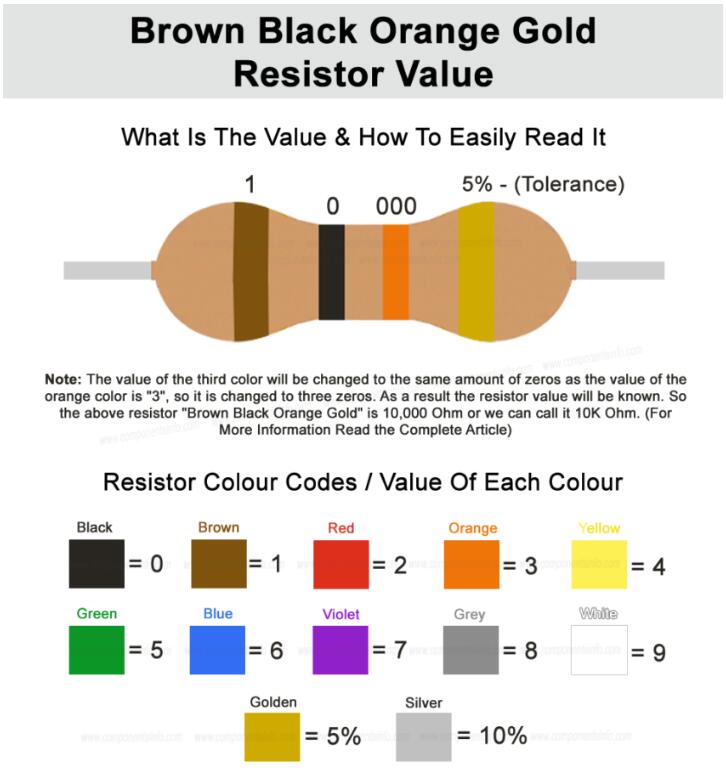The color code "Brown, Black, Orange, Gold" corresponds to the value of a resistor using the standard 4-band resistor color code system. Let's break down the color code:
1st Band (1st significant digit): Brown = 1 2nd Band (2nd significant digit): Black = 0 3rd Band (Multiplier): Orange = 1,000 (x1000) 4th Band (Tolerance): Gold = ±5%

Putting it all together, a resistor with the color code Brown, Black, Orange, Gold represents a resistance value of 10,000 ohms (10K ohms). The gold tolerance band indicates that the actual resistance can deviate by ±5% from the stated value.
Therefore, a resistor with the color code "Brown, Black, Orange, Gold" has a resistance value of 10,000 ohms (10K ohms) with a tolerance of ±5%.
Brown Black Red Gold Resistor Value and How To Read It
The color code "Brown, Black, Red, Gold" corresponds to the value of a resistor using the standard 4-band resistor color code system. Let's break down the color code and understand how to read it:
1st Band (1st significant digit): Brown = 1 2nd Band (2nd significant digit): Black = 0 3rd Band (Multiplier): Red = 100 (x10^2) 4th Band (Tolerance): Gold = ±5%
To read the resistor value:
-
Take the first two bands (Brown, Black) and combine their values: 10. This gives you the first two significant digits of the resistance.
-
Take the third band (Red) and multiply its value by the multiplier to get the decimal multiplier value: 100. This multiplies the 10 by 100, resulting in 1,000. The resulting value represents the third significant digit and the number of zeros to add.
-
Combine the first two significant digits (10) with the number of zeros (3 zeros or 1,000) from the multiplier. This gives you a resistance value of 10,000 ohms or 10 kilohms (10K ohms).
-
The gold tolerance band indicates that the actual resistance can deviate by ±5% from the stated value.
Therefore, a resistor with the color code "Brown, Black, Red, Gold" represents a resistance value of 10,000 ohms (10K ohms) with a tolerance of ±5%.
Alternative Ways to Check a Resistor Value
If you don't have access to a multimeter or you're unable to interpret the color code, there are alternative ways to check a resistor value. Here are a few methods you can try:
-
Resistor Value Chart: Use a resistor value chart or table to manually search for the color code combination you see on your resistor. These charts provide the corresponding resistance values for each color code combination. By matching the colors of the resistor bands with the chart, you can determine the resistor value.
-
Component Identification Apps: There are smartphone apps available that can identify electronic components, including resistors, by analyzing images or color codes. Some apps utilize image recognition technology to detect and provide information about the component, including its value.
-
Online Resistor Value Calculators: Use online resistor value calculators where you can input the colors of the resistor bands, and the calculator will display the corresponding resistance value. Several websites offer this functionality and often include additional features like tolerance and tolerance band selection.
-
Ohm's Law and Voltage/Current Measurements: If you have access to a power supply and a known resistor of a different value, you can set up a simple circuit to measure the voltage drop across the resistor using a voltmeter and the current flowing through it using an ammeter. By applying Ohm's Law (V = I * R) and comparing the measurements with the known resistor, you can calculate the resistance of the unknown resistor.
-
Ask for Help: Seek assistance from someone with experience in electronics or consult a professional who can assist in measuring or interpreting the resistor value accurately.
Remember that these alternative methods may not provide as accurate results as using a multimeter or reading the color code directly. It's always recommended to have a multimeter or a reliable method of reading and checking resistor values for precise and reliable results.
Alternative Way to Make a Quick Resistor Value If You Dont Have One
If you don't have a resistor and need a quick workaround, here's one alternative method you can try:
- Use a Potentiometer: A potentiometer is a variable resistor with three terminals. By connecting the outer two terminals and adjusting the center terminal, you can effectively vary the resistance value. Start by connecting the outer terminals together, forming a fixed resistance value. Then, use the center terminal to adjust the resistance to approximate the desired value.
Keep in mind that potentiometers may not have the same level of precision and stability as fixed resistors, so this method is best suited for temporary or non-critical applications where moderate accuracy is acceptable. Additionally, potentiometers have specific power and voltage ratings, so ensure that the potentiometer you use can handle the power and voltage requirements of your circuit.
It's important to note that for more precise and reliable results, it is generally recommended to use fixed value resistors appropriate for your circuit.




